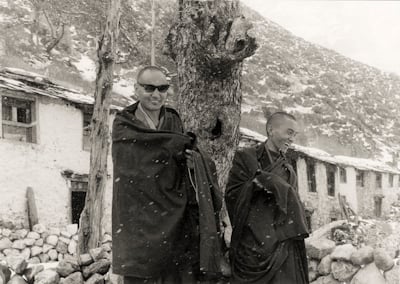The Archive's Dual Mission
The work of the Lama Yeshe Wisdom Archive falls into two Categories: Preservation and Publication.
The Archive contains a wealth of images, audio recordings, videos and transcripts of the precious teachings of Lama Yeshe and Lama Zopa Rinpoche. The collection is maintained in AssetBank, a digital asset management system that ensures the collection will be safely preserved and easily managed for future generations.
We prepare materials for publication through various avenues including books for free distribution and sale, ebooks on a wide range of readers, social media, multimedia, audiobooks, podcasts, videos on our YouTube channel, lightly edited transcripts and free audio on our website, and a monthly e-letter. We also support the translation of LYWA publications into more than eighteen languages.
See below for details on our current initiatives. We are so grateful for your support!
The LYWA Kopan Ebook Project
 In 2024, LYWA launched a new project which involves publication of a series of ebooks of Lama Zopa Rinpoche’s teachings from the Kopan meditation courses held annually at Kopan Monastery in Nepal since the early 1970s. All of Rinpoche’s teachings from the annual Kopan courses will be converted into ebooks, including those already published on our website and those not yet published.
In 2024, LYWA launched a new project which involves publication of a series of ebooks of Lama Zopa Rinpoche’s teachings from the Kopan meditation courses held annually at Kopan Monastery in Nepal since the early 1970s. All of Rinpoche’s teachings from the annual Kopan courses will be converted into ebooks, including those already published on our website and those not yet published.
The Kopan courses began in April 1971 with a ten-day program attended by about a dozen people. From these early beginnings, the Kopan courses evolved to become an annual event with over two hundred attendees from all over the world. Read more here about how the Kopan courses began.
Kopan Monastery is the heart of the FPMT, the international organization founded by Lama Yeshe and Lama Zopa Rinpoche to preserve and spread Mahayana Buddhism worldwide. The Kopan meditation courses were life-changing for countless students, and this is where many students met the Lamas, received teachings and became Buddhist. For more information about attending the annual lamrim courses at Kopan Monastery visit KopanMonastery.com.
LYWA’s Kopan ebook project is possible due to the generous support of donors like you. Your contribution plays a vital role in ensuring that these timeless teachings continue to inspire and transform lives for generations to come. Thank you!
Preserving the Precious Archive for the Future
The Contents of the Archive
 All LYWA materials—audio files, transcripts, images and archival video—have been carefully stored and cataloged. At present, the Archive contains recordings from over 2,100 teaching events encompassing approximately 18,000 hours of audio, almost 16,000 transcripts and hundreds of video recordings.
All LYWA materials—audio files, transcripts, images and archival video—have been carefully stored and cataloged. At present, the Archive contains recordings from over 2,100 teaching events encompassing approximately 18,000 hours of audio, almost 16,000 transcripts and hundreds of video recordings.
The Archive's massive photo collection includes images dating back to the 1940's and has been assembled over the last twenty years from contributions by donors from all over the world. Our Image Archive, managed in Lightroom, contains over 75,000 image files, including many unique, historically relevant images which document the Lamas' travels and teaching events, the origins of international Dharma centers, as well as activities of the many Sangha members, students and friends.
The LYWA collection was organized and enhanced in support of the publication of Lama Yeshe’s biography Big Love: The Life and Teachings of Lama Yeshe, which consists of two 700-page hardcover volumes containing stories, teachings and more than 1,550 images drawn from the Archive’s collection. The FPMT also manages a large collection of images of Lama Zopa Rinpoche and of the myriad FPMT projects and social service programs around the world.
Our Digital Asset Management System: AssetBank
In 2016, LYWA and FPMT joined forces to merge our collections into a single digital asset management system called AssetBank. Previously, LYWA’s collection of audio recordings, archival video recordings, images and transcripts and FPMT’s collection of contemporary video, images and edited transcripts were stored, managed and accessed in systems which were independent of one another. We can now see the incredible benefits of storing all our digital assets in a single system:
Improve preservation and management: Our entire collection is stored in a supported, documented and secure system which positions us well for preserving these precious resources into the future.
Locate materials more easily: The system enables editors and teachers to find all kinds of related files in one place. No more looking in one system for transcripts, another for images, and yet another for video.
Eliminate duplication: Duplicate collections of images, audio and video were often being stored in multiple systems. As our collections of digital assets are categorized in a single system, we are eliminating duplication.
Expand the Archive: AssetBank offers us the opportunity to catalog much more than just our traditional "archive" materials (such as audio, video, image and transcript). As the primary archive of recorded teachings of the Lamas has been migrated to AssetBank, we are now working on cataloging book and magazine design files, education department materials, advices, mantras, articles and other publications.
Meet the future of publishing: As new forms of digital publishing emerge, such as multimedia presentations, having all transcripts, images and video related to the teachings of Lama Yeshe and Lama Zopa Rinpoche categorized, tagged and organized in a single system makes it easier for editors and designers to locate materials quickly for publication.
Increase access to the collection: Moving forward we will be able to offer teachers and book editors the ability to deep dive into unpublished archival material as a resource. And, we will have a vehicle for sharing over 140,000 images in our combined collection to FPMT students worldwide.
Our ultimate goal is to make Lama Yeshe’s and Lama Zopa Rinpoche’s teachings as easily accessible and widely available as possible. LYWA serves primarily students of Lama Yeshe and Lama Zopa Rinpoche but also students of Buddhism from all lineages and traditions. From introductory students and those simply curious about Buddhism in general to more advanced students looking to explore and research topics on their own, all can appreciate the breadth and depth of the teachings we have made available and have yet to make available.
In the years to come, this project will ensure that the precious words and images of our teachers are well cared for, preserving the teachings of the Tibetan Buddhist tradition, and ultimately making its benefits available to all. Please work with us to realize this goal and make your contribution today. Thank you!






























